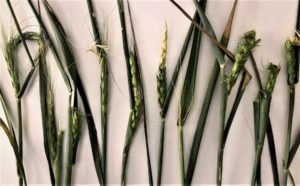Freeze injury in Texas wheat from late-spring frost caused losses, but most acres destined for grain production will likely recover, according to Texas A&M AgriLife Extension Service experts.
Calvin Trostle, Ph.D., AgriLife Extension agronomist, Lubbock, said freeze injuries have varied widely across the Southern Plains and Panhandle.

Areas where temperatures dipped below freezing are assessing damage and will continue, Trostle said. The question will be “how bad” freeze injury could be and whether it might hurt yield potential enough that producers decide to cut fields for haylage rather than risk subpar grain production.
Temperatures in Lubbock reached 31 degrees April 15, which is 10-11 days later than the average final freeze date, he said.
Trostle said one grower in Decatur called with questions about freeze damage, but that it was limited to the top one third of the grain head. The damage occurred before the flowering stage and will likely only affect about 5% to 10% of the yield.
“It’s a situation where yes, there was some damage, but losing the top of the grain head at that point in the plant’s growth process probably won’t hurt the overall yield much because the remaining grains will be larger since they will have less competition for nutrients.”
Trostle said damage can occur when temperatures drop below freezing for two hours but suspects the plant canopy protected wheat fields.
“It can be 30 degrees, but it might be 33 degrees in the canopy,” he said. “There might be reports here and there, but nothing major to be concerned about, so far.”
Wheat freeze injury
Jourdan Bell, Ph.D., AgriLife Extension agronomist, Amarillo, said she doesn’t expect freeze injuries to reduce wheat yields in the Panhandle more than 10% despite temperatures reaching 20 degrees for several hours.
“It’s hard to guess the extent of the damage, and I am not ignoring the fact that it will impact many producers to various degrees, but we probably won’t see losses of more than 10% across the region because wheat was at varying stages of development,” she said. “There were four counties that probably have injuries to 50%-60% of their fields including leaf burn and injury to grain heads.”
Bell said those counties were primarily in the southwest Panhandle where wheat was further along and more susceptible to low temperatures. There was significant leaf tip burn and bleached awns, but of greatest concern are fields with splitting stalks, swollen internodes, damaged spikelets and grain. Many producers in that area who were concerned about injury either cut wheat last week for hay or silage, or they will be doing so in the next few weeks.
“Fields in the northern areas may see fewer injuries because they weren’t as far along,” she said. “Fields in later development stages were much more susceptible to freeze.”
Injured wheat should recover
Emi Kimura, Ph.D., AgriLife Extension agronomist, Vernon, said she saw intermittent damage to wheat during drives around her district. The weather station at Odell reported temperatures fell below 32 degrees for eight hours, and the lowest temperature was 27.9 degrees for one hour.
A recent clinic for wheat growers regarding freeze injury delivered more details about how low temperatures affected some fields.
Kimura said she saw freeze injuries that included freeze-injured kernels on a single side of wheat heads and wheat heads freeze-injured kernels at the top and bottom of the wheat head.
“Freeze injury on the single side of the three-sided wheat heads indicate that side was colder,” she said. “The injury to the top and bottom of the heads indicates the more immature kernels were damaged. Wheat heads grow from the center, so the top and bottom of the head aren’t as far along and therefor are more susceptible to freezing temperatures.”
Kimura said most growers at the clinic reported higher rates of damage in low-lying areas. In some cases, freeze injury was limited to low spots within hundreds of acres while wheat grown in upland fields seemed to only have minor injury.
“The freeze injury was very inconsistent and varied widely across and within fields, and there are still a lot of questions regarding how those injured fields will perform going forward,” she said.
Kimura said other conditions like moisture, sunlight and disease pressure could make or break some wheat fields. She said conditions have been drying in her district and lack of moisture is another problem in addition to the freeze event.

